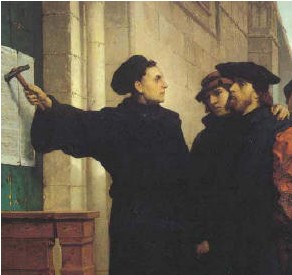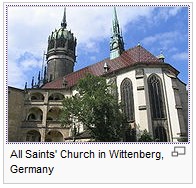 Related Articles
Related Articles
|
|
|
 Websites
Websites
|
|
|
|
|
The Kirk in Crisis: nailing colours to the door
A current move by Church of Scotland congregations from across Scotland sets down a very significant marker in terms of a public response to the highly-controversial decisions made by the recent General Assembly.
 Yesterday saw a significant development in the crisis threatening the unity of the Church of Scotland when 35 churches from right across Scotland resolved to post their beliefs on congregational notice boards. Yesterday saw a significant development in the crisis threatening the unity of the Church of Scotland when 35 churches from right across Scotland resolved to post their beliefs on congregational notice boards.
In the list of individual churches publicly stating their biblical stance – including those relating to human sexuality – are congregations from across the Highlands and Islands; from Inverness to Scourie and Lewis and Harris.
This action could be seen as 'nailing colours to the door' in response to the Kirk's persistent 'nailing colours to the fence' over major issues and over a considerable period of years.
The ‘covenant’ which the group of churches affirm states (amongst other core beliefs):
‘We recognize God’s creation of humankind as male and female and the unchangeable standard of Christian marriage between one man and one woman as the proper place for sexual intimacy and the basis of the family. We acknowledge the great harm that has come from our failures to maintain this standard, and we repent and call for a renewed commitment to lifelong fidelity in marriage and abstinence for those who are not married.’
And then follows on with:
‘We reject the authority of those who have denied the orthodox faith in word or deed. We pray for them and call on them to repent and return to the Lord.’
This move potentially places these churches in direct confrontation with the national body.
A triumvirate of offence
As most will be aware the Church of Scotland was thrown into this deep crisis following debate at the May 2009 General Assembly whereby two extremely important decisions were made.
The first of these related to the (then-forthcoming) intention by Aberdeen Presbytery (group of churches in that city) to appoint an openly-gay minister to Queen’s Cross Church. [That appointment has now taken place.]
The second debate on the issue of sexuality saw the Assembly, using procedural devices, to effectively disable an overture (motion) from churches in the Lochcarron/Skye Presbytery (requesting the Assembly to affirm the traditional view on marriage and sexuality) and alternatively appoint a Special Commission to report back in two years time to the General Assembly in 2011.
The Assembly also imposed a ‘gagging-order’ forbidding any official church courts or representatives from speaking publicly on the matter.
To add to insult to injury, and to the concern – nay disgust – of many, a senior minister also regaled the Assembly in stand-up comic form with tales of his pre-marital sexual activities.]
As a direct result of these developments a seismic shockwave has shaken the Church to its foundations.
In advance of the Assembly a newly-formed grouping calling itself the Fellowship of Confessing Churches launched an on-line petition (unsuccessfully) invited the Assembly to affirm the orthodox view on sexuality. The petition attracted over twelve thousand signatures from churches and individuals across the denominations and from around the world. The FCC website also carried, and still does, a ‘Covenant’ which clearly sets out what the grouping and those affiliated with it believe.
Ripples appearing on the surface
Subsequent to the Assembly there has been a very considerable level of discussion within the orthodox wing of the church, but the great majority of this has necessarily – in compliance with the Assembly’s moratorium on public discussion – been conducted privately.
And just over a month after the Assembly, most Scots go on summer holiday. Accordingly for the month of July most have been taking a break and work-related activities and discussion take second place to rest and recreation.
The net effect of this has been an impression that little is happening. But this could not be further from the truth. Whilst in the main precipitate and public responses to the Assembly’s decisions have been muted there has been a groundswell of reaction; or to be more accurate differing reactions.
Diverse situations; varied responses
The Church of Scotland (at minister level) is – at any one time – in a situation of diversity. Some ministers are in the process of training, some newly-trained are serving in probationer capacity, others have moved to new congregations whilst many are also approaching retirement. [The post-war ‘baby boom’ demographic is at this stage.]
This, along with other significant factors, results in a diverse set of responses across the trainee and clergy spectrum. Whilst everyone (of orthodox views) is extremely concerned, some feel that they are not in a position to leave whilst many feel that they cannot possibly stay. And no-one – on either side of the issue – believes that the Special Commission’s report will, in two years time, effectively reverse the situation. [It is widely acknowledged that the liberal wing of the Church has an agenda running and is not for turning.]
As stated above, for the believer in the pew (and certainly for the person in the street) the impression has been that nothing much is happening. And for Church members this can be extremely disconcerting.
Clear statement; decisive leadership
However yesterday marked a significant and open public response to the situation of confusion into which the Kirk has placed itself. Though the numbers involved represent a small fraction of the C of S congregations across Scotland, with it being the summer period and the fact that significant decisions in a congregation need to be taken by the respective Kirk Sessions (council of elders) it could well be that others will add their names to the list. What the action does do is remove any ambiguity regarding what these local churches, respectively and collectively, believe; and the action is an example of clear and decisive leadership.
Yet another component in all of this relates to the decisions by more than a few (congregations and individual believers) to withhold financial givings to the Kirk’s national coffers. [ In monetary terms, those of orthodox belief are by far the biggest contributors.] And given that the Church – by its own admission and prior to all of this – is heading for bankruptcy, it could well be that a drastic fall in income could overtake the debate on sexuality.
Comment:
There are hundreds and hundreds of good people in the Church of Scotland; some believe the Bible and choose to order their affairs around God’s word. Others, it would seem, are prepared to move with the flow of sociological trends in order to stay ‘modern’. Both of these groupings can confidently expect to receive exactly what their efforts deserve.These are significant times indeed.
But for those who are holding fast to the ‘faith that was once for all entrusted to the saints’ (Jude 1:3) they can be assured that the God they worship has not changed. And the Jesus and his teachings that they follow will long outlast every institution that man has ever created. Jesus said: “I will build my church; and the gates of hell shall not prevail against it.” (Matt 16:18).
---------
Footnotes:
1. The signatories to the FCC website petition in May were affirming the petition to the General Assembly of that month. This was (and is) a separate action from the current action by the following churches concerned to affirm the FCC ‘covenant’.
2. The churches which are reportedly displaying the FCC covenant are:
St George's Tron, St Rollox, St Margaret's Tollcross, Partick Trinity, Carmyle Church (all Glasgow); Kirk o' Shotts, Lanarkshire; St John's Town of Dalry Parish Church, Castle Douglas, Dumfriesshire; Old Luce, New Luce (Newton Stewart); Troqueer Parish Church, Dumfries; Loudoun Church, Newmilns; St Andrew's Church, Harthill; New Restalrig Church, Holyrood Abbey Church, Davidson's Mains Church, St Catherine's Argyle (Edinburgh); Gilcomston South, High Church Hilton (Aberdeen); Macduff Parish Church, Gardenstown; St Kane's, New Deer;
And in the Highlands and Islands:
Kinmylies Church, East Church (Inverness); Alness; Durness & Kinlochbervie; Lochalsh Parish, Glenelg & Kintail (Kyle of Lochalsh); Kilmuir & Stenscholl, Strath & Sleat Parish (Skye) High Church Stornoway, Lochs Crossbost, Barvas Parish (Lewis) Tarbert, Manish-Scarista (Harris) Benbecula Church.
3. In 1517 Martin Luther famously nailed his 95 theses to the door of the Castle Church in Wittenberg (Germany) – an action which in the figurative sense started the 16th Century Reformation.
 
 4. (Rev.) Jeremy Middleton (Davidson's Mains Church, Edinburgh) has responded in his blog to the article published (06/08/09) in the Herald newspaper with a view to countering the confrontational and provocative reporting. 4. (Rev.) Jeremy Middleton (Davidson's Mains Church, Edinburgh) has responded in his blog to the article published (06/08/09) in the Herald newspaper with a view to countering the confrontational and provocative reporting.
|
Christians Together, 07/08/2009
|
|
|
|